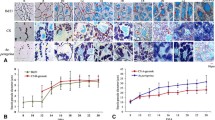Abstract.
Dehydrins accumulate in various plant tissues during dehydration. Their physiological role is not well understood, but it is commonly assumed that they assist cells in tolerating dehydration. Since in perennials the ability of the shoot apex to withstand dehydration is pivotal for survival through winter, we investigated if and how dehydrins may be involved. A first step in assessing such a role is the identification of their subcellular location. We therefore mapped the location of dehydrin homologues, abscisic acid-responsive (RAB 16-like) polypeptides, in the apex of birch (Betula pubescens Ehrh.). In non-cold-acclimated plants a single low-abundant RAB 16-member (a 33-kDa polypeptide) was produced, and localized in the cytoplasm only. During cold acclimation two additional members were produced (24 and 30 kDa) and accumulated in nuclei, storage protein bodies and starch-rich amyloplasts. Western blots of proteins isolated from purified starch granules and from protein bodies revealed the presence of the 24-kDa dehydrin. Since starch and protein reserves are gradually consumed during winter, serving cell maintenance, starch- and protein-degrading enzymes must remain locally active. We therefore investigated the hypothesis that dehydrins might create local pools of water in otherwise dehydrated cells, thereby maintaining enzyme function. In agreement with our hypothesis, enzyme assays showed that under conditions of low water activity a partially purified dehydrin fraction was able to improve the activity of α-amylase (EC 3.2.1.1.) relative to fractions from which dehydrin was removed by immunoprecipitation. The results confirm the general belief that dehydrins serve desiccation tolerance, and suggest that a major function is to rescue the metabolic processes that are required for survival and re-growth.
Similar content being viewed by others
Author information
Authors and Affiliations
Additional information
Received: 12 September 1998 / Accepted: 19 April 1999
Rights and permissions
About this article
Cite this article
Rinne, P., Kaikuranta, P., van der Plas, L. et al. Dehydrins in cold-acclimated apices of birch (Betula pubescens Ehrh.): production, localization and potential role in rescuing enzyme function during dehydration. Planta 209, 377–388 (1999). https://doi.org/10.1007/s004250050740
Issue Date:
DOI: https://doi.org/10.1007/s004250050740




